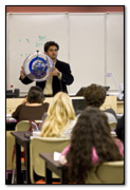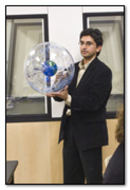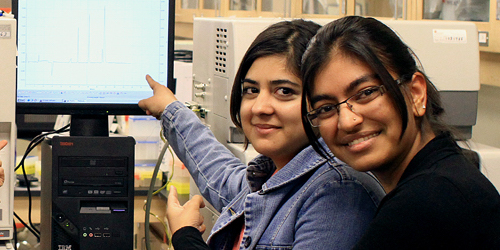 Science technology is ever evolving, similar to the growing Nevada State College campus community. With the Liberal Arts and Sciences Building, NSC has acquired cutting-edge science equipment which provides a superior student learning experience.
Science technology is ever evolving, similar to the growing Nevada State College campus community. With the Liberal Arts and Sciences Building, NSC has acquired cutting-edge science equipment which provides a superior student learning experience.
Particularly exciting are the new telescopes in the Liberal Arts and Sciences Building, offering progressive learning options to NSC students.
Students in Astronomy classes now have access to one 11 and two 16 diameter telescopes made by Celestron. Previously, NSC only had 8 telescopes. Having larger telescopes is significant, as the function of the telescope is to essentially collect light. The wider the diameter of the telescope, the more light you can collect, making it easier to observe the details of the deep sky objects. These telescopes are fully equipped with auto guides. By simply typing in the coordinates, the auto guide directs itself to what you are trying to locate.
NSC telescopes will get clearer views of the galaxies, given the LAS building’s location on its more than 500-acre master planned campus site, removed from the hustle and bustle of the Las Vegas Metropolitan area.
Dr. Sandip Thanki, Chair of Physical Sciences at NSC, believes this type of interactive learning not only provides students a taste of what astronomers would do in their research, but also makes the physical sciences more accessible.
Many students are not aware of how the sciences are so integrated into their everyday lives, Dr. Thanki said. What students are able to do now is more advanced in comparison to what was available a couple of years ago due to the ever-evolving technology, Thanki continued.
The new advanced telescopes also have Charge Coupled Device (CCD) cameras, which are similar to modern, personal digital cameras. Instead of just pointing out different objects in the sky, they take actual pictures of the galaxies, from which students can perform research and produce reports on their findings.
We are a young school and we have access to technology that can easily prepare us for our future careers. What more could a student ask for? comments Nevada State College junior Velanie Williams.
Williams has taken Astronomy 104 and is looking forward to taking the lab portion of the class next semester. I am extremely excited about the new 16-inch telescopes that we have acquired for the Astronomy classes. They will make learning about the stars so much more electrifying when you have the ability to see what you are studying so clearly, Williams said. Additionally, Williams has felt her perception of science has changed, based on her classroom experiences at NSC. My science classes have really broadened my learning horizons and given me a different outlook on my college career.
In addition to the new telescopes in the Liberal Arts and Sciences Building, there are various other advanced  technologies available to students and teachers. With the oscilloscope, students will be able to measure the speed of light and time varying electrical signals. Additionally, students can measure kinetic energies and energy losses in collisions with the ballistic pendulum, an instrument widely used in physics classes to demonstrate properties of momentum and energy. The spectrometer, an optical instrument used to measure properties of light, will provide opportunities to study light wavelengths and electronic configurations of atoms.
technologies available to students and teachers. With the oscilloscope, students will be able to measure the speed of light and time varying electrical signals. Additionally, students can measure kinetic energies and energy losses in collisions with the ballistic pendulum, an instrument widely used in physics classes to demonstrate properties of momentum and energy. The spectrometer, an optical instrument used to measure properties of light, will provide opportunities to study light wavelengths and electronic configurations of atoms.
Providing a learning environment with enhanced technology not only puts the sciences within students reach, but also opens new pathways of lifelong learning.
For more information on Nevada State College, call : 702.990.2000 or visit : nsc.edu.
New Physics Science Technology Enhances Student Learning Experiences
